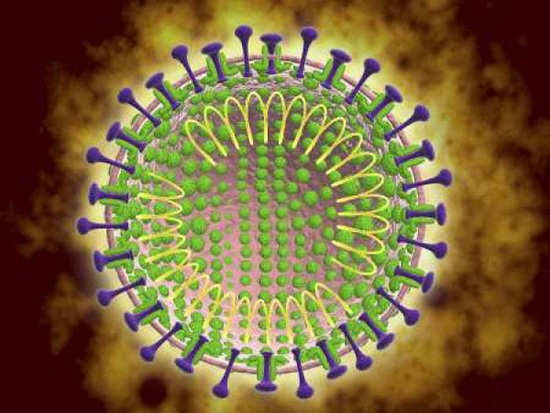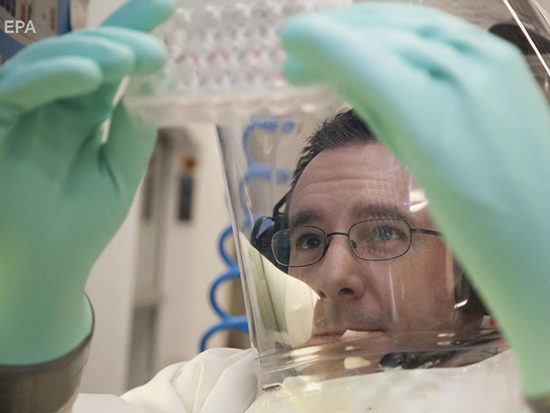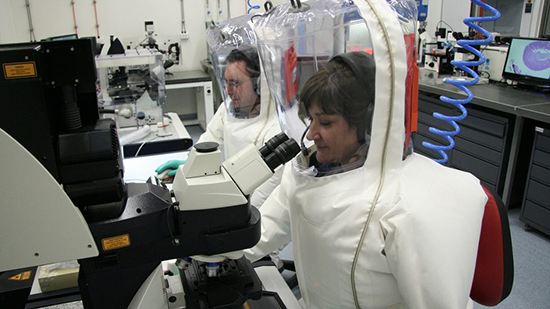A new strain of SARS-CoV-2 coronavirus that causes a deadly infectious disease. The microorganism differs from its predecessors in the totality and construction of a chain of genes containing biological information. The genome of the coronavirus has a structure in the form of RNA, which allows it to penetrate into any cells of a living organism.
What does the new coronavirus look like?
Microbiologists managed to differentiate and examine the cell under a microscope. The microorganism was named "new coronavirus Wuhan strain 01 or 2019 ncov".

In order to present to the public a picture of a microbe, American microscopists created a 3D color photo using a computer program.
What the coronavirus looks like (main differences):
- cell size is not more than 100 nm (nanometer - 10 -9 m);
- the virus has spikes around the circumference, for which it received the name "coronavirus";
- on the body of the microorganism there are viral particles (round, oval bodies);
- inside the cell are located in the form of plaques - negative colonies of the virus;
- when leaving the cell, they represent a colonial line or a heap cluster.
The genome of the new Chinese coronavirus: information from scientists
The SARS-CoV-2 coronavirus genome has already been deciphered and published. It is a single stranded RNA virus. 28 genomes have been deciphered, with the exception of one, the earliest.

This family is dangerous to human health. When introduced into the body, SARS-CoV-2 causes severe complications incompatible with life:
- atypical pneumonia - compaction (healing) of the lung tissue, filling the alveoli not with air, but with liquid (pus, blood), blocking gas exchange, oxygen starvation of the whole organism, respiratory arrest;
- violation of glomerular filtration of the kidneys - acidosis (blood oxidation), an irreversible violation of metabolic processes;
- acute renal failure - kidney failure (death occurs after 4 hours).
The structure of the virus has a specific linear RNA, the length of which is 30,000 nucleotides (organic compounds). Most sites are not broadcast. The regions that are encoded are divided into subgroups of 10 proteins. Their transcription (the use of a human cell as a template for replication) occurs in a nested manner, which makes the virus highly toxic and infectious. The binding receptor for the virus is the ACE enzyme, which is located in the extracellular space of the human body.
Coronaviruses are distinguished by a complex genome expression strategy - the transfer of hereditary information from a gene to a protein or RNA. Each time a new unique sequence is translated in the chain, which leads to the reproduction of different types of viral proteins. It was this fact that became the cornerstone in the rapid invention of the coronavirus vaccine.

The main difference between the virus and its predecessors is the transmission of infection from person to person. Previously, it was believed that the mechanism of transmission occurs exclusively from animals that carry the virus (bats).
Based on the isolated genome, leading scientists with world recognition confirmed with confidence the information that the origin of the coronavirus is natural. This refutes rumors that the microorganism was created artificially as a biological weapon of mass destruction. Experts urge not to panic, but to check information from official sources, confirmed by scientific evidence.
Help from Russian scientists
Russian scientists of the Siberian Branch of the Russian Academy of Sciences are actively developing diagnostic tests for the rapid differentiation of a viral infection. Experts refute the claim that with the advent of warm weather, the coronavirus is deactivated. An increase in air temperature does not affect the activity of the microorganism. Scientists warn of a second wave of the outbreak in May-June 2020.
Therefore, continuous scientific work in the field of microbiology is carried out in Russia. Coordinating with the WHO and leading Hong Kong virologists, scientists are looking for preventive and curative options to counter the infection.
The management of the Center for Strategic Planning of Medical and Biological Health Risks of the Ministry of Health of the Russian Federation plans to complete the development of rapid diagnostic tests for the detection of coronavirus in March 2020. Scientific work has been carried out since January 14 of this year, when the decoding of the genome of the new virus appeared in the international GenBank database.

When will there be a vaccine for this virus?
Vaccine development is a laborious and lengthy process. In China, scientists from all over the world have been working on this issue since December 2019. They will present several types of vaccines that are already being tested on animals today.
Initially, it was planned to start large-scale production of antiviral drugs after January 25, 2020. But in order to improve the effectiveness of the drug and safety for patients, it was decided to postpone the launch of mass production until the summer of 2020.
Drugs are developed based on fragments of the genetic code of the coronavirus. After the introduction into the body and the entry of the substance into the cell, the proteins of the pathogenic microorganism begin to be actively produced. In response, an active immune response is launched. This is how immunity to disease is developed.
Today, 4 strains of coronavirus have already been isolated, which provoke severe complications and death. Vaccines do not yet exist for any of the identified species.
Regarding the effectiveness of future vaccines, virologists do not give 100% positive forecasts. The effect of the drug in elderly patients, among whom the highest mortality statistics, will continue to be at risk. This is due to weakened immunity, slow metabolic processes in the aging body. Do not exclude the development of serious side effects when using an experimental vaccine.